WASHINGTON — NASA is building a space telescope to search for the hardest-to-find asteroids and comets that stray into Earth’s orbital neighborhood.
The space agency’s Near-Earth Object Surveyor (NEO Surveyor) recently passed a rigorous technical and programmatic review. Now the mission is transitioning into the final design-and-fabrication phase and establishing its technical, cost, and schedule baseline, NASA said.
The mission supports the objectives of NASA’s Planetary Defense Coordination Office (PDCO) at NASA Headquarters in Washington. The agency’s Planetary Missions Program Office at Marshall Space Flight Center provides program management for NEO Surveyor.
“NEO Surveyor represents the next generation for NASA’s ability to quickly detect, track, and characterize potentially hazardous near-Earth objects,” said Lindley Johnson, NASA’s Planetary Defense Officer at PDCO. “Ground-based telescopes remain essential for us to continually watch the skies, but a space-based infrared observatory is the ultimate high ground that will enable NASA’s planetary defense strategy.”
NEO Surveyor will journey a million miles to a region of gravitational stability between Earth and the sun, where the spacecraft will orbit during its five-year primary mission, the space agency said.
From this location, the NEO Surveyor will view the solar system in infrared wavelengths – light that is invisible to the human eye. Because those wavelengths are mostly blocked by Earth’s atmosphere, larger ground-based observatories may miss near-Earth objects that this space telescope will be able to spot by using its modest light-collecting aperture of nearly 20 inches.
NASA said NEO Surveyor’s cutting-edge detectors are designed to observe two heat-sensitive infrared bands that were chosen specifically so the spacecraft can track the most challenging-to-find near-Earth objects, such as dark asteroids and comets that don’t reflect much visible light. In the infrared wavelengths to which NEO Surveyor is sensitive, these objects glow because they are heated by sunlight.
In addition, NEO Surveyor will be able to find asteroids that approach Earth from the direction of the sun, as well as those that lead and trail Earth’s orbit, where they are typically obscured by the glare of sunlight – objects known as Earth Trojans.
“For the first time in our planet’s history, Earth’s inhabitants are developing methods to protect Earth by deflecting hazardous asteroids,” said Amy Mainzer, the mission’s survey director at the University of Arizona . “But before we can deflect them, we first need to find them. NEO Surveyor will be a game-changer in that effort.”
The mission will also help to characterize the composition, shape, rotation, and orbit of near-Earth objects. While the mission’s primary focus is on planetary defense, this information can be used to better understand the origins and evolution of asteroids and comets, which formed the ancient building blocks of our solar system.
Don’t miss out! Subscribe to our email newsletter to have all our smart stories delivered to your inbox.



